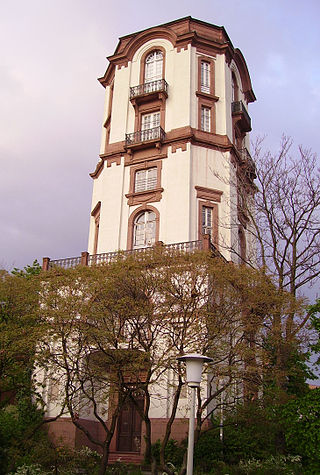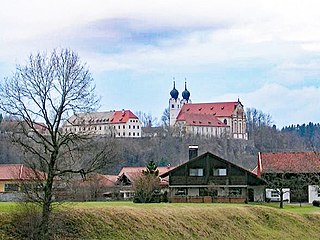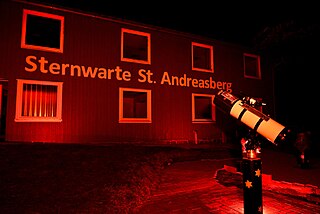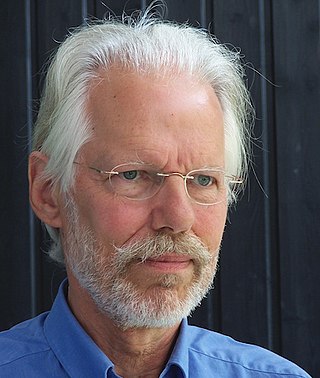
Ole Christensen Rømer was a Danish astronomer who, in 1676, made the first measurement of the speed of light and discovery that light travels at a finite speed. Rømer also invented the modern thermometer showing the temperature between two fixed points, namely the points at which water respectively boils and freezes.

Regensburg is a city in eastern Bavaria, at the confluence of the Danube, Naab and Regen rivers, Danube's northernmost point. It is the capital of the Upper Palatinate subregion of the state. With more than 150,000 inhabitants, Regensburg is the fourth-largest city in the State of Bavaria after Munich, Nuremberg and Augsburg and the 8th largest of all cities on the Danube river. From its foundation as an imperial Roman river fort, the city has been the political, economic and cultural centre of the surrounding region. Later, under the rule of the Holy Roman Empire, it housed the Perpetual Diet of Regensburg.

Astronomical symbols are abstract pictorial symbols used to represent astronomical objects, theoretical constructs and observational events in European astronomy. The earliest forms of these symbols appear in Greek papyrus texts of late antiquity. The Byzantine codices in which many Greek papyrus texts were preserved continued and extended the inventory of astronomical symbols. New symbols have been invented to represent many planets and minor planets discovered in the 18th to the 21st centuries.

Christoph Scheiner SJ was a Jesuit priest, physicist and astronomer in Ingolstadt.

The Berlin Observatory is a German astronomical institution with a series of observatories and related organizations in and around the city of Berlin in Germany, starting from the 18th century. It has its origins in 1700 when Gottfried Leibniz initiated the "Brandenburg Society of Science″ which would later (1744) become the Prussian Academy of Sciences. The Society had no observatory but nevertheless an astronomer, Gottfried Kirch, who observed from a private observatory in Berlin. A first small observatory was furnished in 1711, financing itself by calendrical computations.

Ettal Abbey is a Benedictine monastery in the village of Ettal close to Oberammergau and Garmisch-Partenkirchen in Bavaria, Germany. With a community of more than 50 monks, with another five at Wechselburg, the Abbey is one of the largest Benedictine houses and is a major attraction for visitors.

Konkoly Observatory is an astronomical observatory located in Budapest, Hungary is part of the Research Centre for Astronomy and Earth Sciences and belongs to the HUN-REN Magyar Kutatási Hálózat. Konkoly Observatory was founded in 1871 by Hungarian astronomer Miklós Konkoly-Thege (1842–1916) as a private observatory, and was donated to the state in 1899. Konkoly Observatory, officially known as HUN-REN CSFK Konkoly Thege Miklós Csillagászati Intézet in Hungarian, is the largest astronomical research institute in Hungary, and hosts the largest telescopes in the country. The Observatory has more than 60 researchers, a quarter of them are non-Hungarian.

Hoher ListObservatorium is an Observatory located on the Hoher List mountain about 60 km south-west of the city of Bonn, close to the town of Daun in the Eifel region (Rhineland-Palatinate)

Hamburg Observatory is an astronomical observatory located in the Bergedorf borough of the city of Hamburg in northern Germany. It is owned and operated by the University of Hamburg, Germany since 1968, although it was founded in 1825 by the City of Hamburg and moved to its present location in 1912. It has operated telescopes at Bergedorf, at two previous locations in Hamburg, at other observatories around the world, and it has also supported space missions.

The Archenhold Observatory was named in honour of Friedrich Simon Archenhold, is an observatory in Berlin-Treptow. It houses the Großer Refraktor, which is the longest pointable telescope in the world. It is also called Die Himmelskanone.
The Cecilian Movement for church music reform began in Germany in the second half of the 1800s as a reaction to the liberalization of the Enlightenment.

Leibniz Institute for Astrophysics Potsdam (AIP) is a German research institute. It is the successor of the Berlin Observatory founded in 1700 and of the Astrophysical Observatory Potsdam (AOP) founded in 1874. The latter was the world's first observatory to emphasize explicitly the research area of astrophysics. The AIP was founded in 1992, in a re-structuring following the German reunification.

The Mannheim Observatory was a tower observatory built between 1772 and 1774 in Mannheim, Germany, which remained in operation until 1880. The observatory was transferred to Karlsruhe and finally in 1898, was established on the Königstuhl near Heidelberg where today's successor institution the State Observatory Heidelberg-Königstuhl is located.

Göttingen Observatory is a German astronomical observatory located in Göttingen, Lower Saxony, Germany.
Karl Eschweiler was an academic Catholic theologian in Germany, who, as a so-called brown priest, publicly promoted cooperation and reconciliation between the church and the Nazi regime from 1933 onwards. He believed that a dictatorship would benefit the church, as it would stem the tide of secularist modernism that he saw as eroding the church’s authority.

Baumburg Abbey is a former monastery of Augustinian Canons Regular in the northern Traunstein district of Bavaria, Germany. It was founded in 1107–1109 and dissolved in 1803. Today Baumburg is a Catholic deanery that covers the parishes of the northern Chiemgau.

The Sankt Andreasberg Observatory, also called Harz Observatory, is a project of the charitable society Sternwarte Sankt Andreasberg e. V., which translates into Sankt Andreasberg Observatory registered society. It was opened in August 2014 and is supposed to become the first completely barrier free Observatory in Germany. The society's expressive goal is to make the sky accessible to all people, whether they are disabled or not. Celestial observation, lectures and Workshops convey general astronomical knowledge to visitors.

The Observatorio Manuel Foster, or Manuel Foster Observatory, is an astronomical observatory constructed on Cerro San Cristóbal near Santiago, Chile in 1903. This site was originally known as the D. O. Mills Observatory after the philanthropist Darius Ogden Mills. It was built as an offshoot of the Lick Observatory to observe stars in the southern hemisphere, and, under the direction of the American astronomer W. W. Campbell, was used in an extensive project to determine the apex of the Sun's motion through space.

Klaas Sjoerds de Boer is a Dutch astronomer and astrophysicist as well as Professor at the University of Bonn. His research mainly consisted of using data obtained with satellites and from Earth bound telescopes.

The Wilhelm Foerster Observatory in Berlin is a large public observatory which allows visitors to observe the sky through several telescopes. The facility is named after the German astronomer Wilhelm Foerster.























